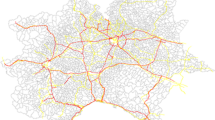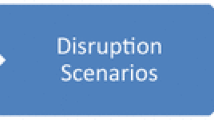Abstract
Much of the literature in recent years has examined the vulnerability of transportation networks. To identify appropriate and operational measures of nodal centrality using connectivity in the case of heavy rail systems, this paper presents a set of comprehensive measures in the form of a Degree of Nodal Connection (DNC) index. The DNC index facilitates a reevaluation of nodal criticality among distinct types of transfer stations in heavy rail networks that present a number of multiple lines between stations. Specifically, a new classification of transfer stations—mandatory transfer, non-mandatory transfer, and end transfer—and a new measure for linkages—link degree and total link degree—introduces the characteristics of heavy rail networks when we accurately expose the vulnerability of a node. The concept of partial node failure is also introduced and compare the results of complete node failure scenarios. Four local and global indicators of network vulnerability are derived from the DNC index to assess the vulnerability of major heavy rail networks in the United States. Results indicate that the proposed DNC indexes can inform decision makers or network planners as they explore and compare the resilience of multi-hubs and multi-line networks in a comprehensive but accurate manner regardless of their network sizes.
Similar content being viewed by others
References
Albert, R., Jeong, H., Barabasi, A.L.: Error and attack tolerance of complex networks. Nature 406, 378–382 (2000)
Angeloudis, P., Fisk, D.: Large subway systems as complex networks. Physica A 367, 553–558 (2006)
Arulselvan, A., Commander, C. W., Elefteriadou, L., Pardalos, P. M.: Detecting critical nodes in sparse graphs. Comput. Oper. Res. 36(7), 2193–2200 (2009)
Cats, O., Jenelius, E.: Beyond a complete failure: the impact of partial capacity degradation on public transport network vulnerability. Transp. B Transp. Dyn. (2016). https://doi.org/10.1080/21680566.2016.1267596
Chiou, S.W.: Vulnerability analysis of a signal-controlled road network for equilibrium flow. In: Márquez, F.P.G., Lev, B. (eds.) Advanced Business Analytics, pp. 109–142. Springer, Cham (2015)
D’Este, G.M., Taylor, M.A.P.: Network vulnerability: an approach to reliability analysis at the level of national strategic transport networks. In: Iida, Y., Bell, M.G.H. (eds.) The Network Reliability of Transport, pp. 23–44. Pergamon, New York (2003)
D’lima, M., Medda, F.: A new measure of resilience: an application to the London underground. Transp. Res. Part A 81, 35–46 (2015)
Demsar, U., Spatenkova, O., Virrantaus, K.: Identifying critical locations in a spatial network with graph theory. Trans. GIS 12, 61–82 (2008)
Derrible, S., Kennedy, C.: Characterizing metro networks: state, form, and structure. Transportation 37(2), 275–297 (2010a)
Derrible, S., Kennedy, C.: The complexity and robustness of metro networks. Physica A 389(17), 3678–3691 (2010b)
El-Rashidy, R.A., Grant-Muller, S.M.: An assessment method for highway network vulnerability. J. Transp. Geogr. 34, 34–43 (2014)
Grubesic, T.H., O’Kelly, M.E., Murray, A.T.: A geographic perspective on commercial Internet survivability. Telemat. Inform. 20(1), 51–69 (2003)
Holmgren, A.J.: A framework for vulnerability assessment of electric power systems. In: Murray, A.T., Grubesic, T.H. (eds.) Critical Infrastructure, pp. 31–55. Springer, Heidelberg (2007)
Kim, H.: Geographical analysis on network reliability of public transportation systems: a case study of subway network system in Seoul. J. Korean Geogr. Soc. 44(2), 187–205 (2009)
Kim, H.: p-Hub protection models for survivable hub network design. J. Geogr. Syst. 14(4), 437–461 (2012)
Kim, H., Kim, C., Chun, Y.: Network reliability and resilience of rapid transit systems. Prof. Geogr. 68(1), 53–65 (2016)
Kim, H., Ryerson, M.S.: The q-Ad hoc hub location problem. Netw. Spat. Econ. 17(3), 1015–1041 (2017)
Kim, H., Song, Y.: Examining accessibility and reliability in the evolution of subway systems. J. Public Transp. 18(3), 89–106 (2015)
Kurauchi, F., Sumalee, A., Seto, Y.: Network evaluation based on connectivity vulnerability. In: Lam, W.H.K., Wong, S.C., Lo, H.K. (eds.) Transportation and Traffic Theory, pp. 637–676. Routledge, New York (2009)
Li, Y., Kim, H.: Assessing survivability of the Beijing subway system. Int. J. Geospat. Environ. Res. 1(1), 1–22 (2014)
Matisziw, T.C., Murray, A.T., Grubesic, T.H.: Exploring the vulnerability of network infrastructure to interdiction. Ann. Reg. Sci. 43(2), 307–321 (2009)
Murray, A.T.: An overview of network vulnerability modeling approaches. GeoJournal 78(2), 209–221 (2013)
Murray, A.T., Grubesic, T.: Reliability and Vulnerability in Critical Infrastructure: A Quantitative Geographic Perspective. Springer, Heidelberg (2007)
Murray, A.T., Matisziw, T.C., Grubesic, T.H.: Critical network infrastructure analysis: interdiction and system flow. J. Geogr. Syst. 9, 103–117 (2007)
Myung, Y.S., Kim, H.J.: A cutting plane algorithm for computing k-edge survivability of a network. Eur. J. Oper. Res. 156, 579–589 (2004)
Nakanishi, Y.J.: Securing America’s mass transit systems. J. Transp. Secur. 2(1), 9–11 (2009)
O’Kelly, M.E., Kim, H.: Survivability of commercial backbones with peering: a case study of Korean networks critical infrastructure. In: Murray, A.T., Grubesic, T.H. (eds.) Reliability and Vulnerability, pp. 107–128. Springer, Berlin (2007)
O’Kelly, M.E.: Network hub structure and resilience. Netw. Spat. Econ. 15(2), 235–251 (2014)
Rashidi, E.: Optimization models and algorithms for vulnerability analysis and mitigation planning of pyro-terrorism. ProQuest Dissertations Publishing, Mississippi State University (2016)
Rodrigue, J.P., Comtois, C., Slack, B.: The Geography of Transport Systems, 4th edn. Routledge, New York (2017)
Rodríguez-Núñez, E., García-Palomares, J.C.: Measuring the vulnerability of public transport networks. J. Transp. Geogr. 35, 50–63 (2014)
Schoon, M.: A short historical overview of the concepts of resilience, vulnerability, and adaptation. Workshop in Political Theory and Policy Analysis, Indiana University Working Paper W05-4 (2005)
Sun, D., Guan, S.: Measuring vulnerability of urban metro network from line operation perspective. Transp. Res. Part A 94, 348–359 (2016)
Sun, D., Zhao, Y., Lu, Q.C.: Vulnerability analysis of urban rail transit networks: a case study of Shanghai, China. Sustainability 7(6), 6919–6936 (2015)
The BART (San Francisco, CA) network https://www.bart.gov/stations. Accessed April 2016
The CTA (Chicago, IL) network http://www.transitchicago.com/assets/1/maps/ctatrainmap.png. Accessed July 2017
The GCRTA (Cleveland, OH) network http://www.riderta.com/sites/default/files/pdf/maps/System_Map_Rapid_Connect.pdf. Accessed Apr 2016
The LACMTA (Los Angeles, CA) network https://media.metro.net/documents/8f0fe43e-da3b-4a10-bd8e-4cfd54e30eb3.pdf. Accessed Sept 2016
The Local fr (2017). https://www.thelocal.fr/20170717/the-transport-works-set-to-disrupt-your-summer-in-parisand-elsewhere-in-france. Accessed Oct 2017
The MARTA (Atlanta, GA) network http://www.itsmarta.com/train-stations-and-schedules.aspx. Accessed Apr 2016
The MBTA (Boston, MA) network http://www.mbta.com/schedules_and_maps/subway/. Accessed Apr 2016
The MDT (Miami, FL) network http://www.miamidade.gov/transit/metrorail-stations.asp and https://www.miami-dade.gov/transit/metromover-stations.asp. Accessed Apr 2016
The NYCT (New York, NY) network http://web.mta.info/maps/submap.html. Accessed Apr 2016
The PATH (New York, NY) network http://www.panynj.gov/path/maps.html. Accessed Apr 2016
The SEPTA (Philadelphia, PA) network http://septa.org/maps/system/. Accessed Apr 2016
The WMATA (Washington, DC) network https://wmata.com/schedules/maps/upload/system_map_color.pdf. Accessed May 2017
Wan, N., Zhan, F., Cai, Z.: A spatially weighted degree model for network vulnerability analysis. Geo-spat. Inf. Sci. 14(4), 274–281 (2011)
Wang, J., Li, Y., Liu, J., He, K., Wang, P.: Vulnerability analysis and passenger source prediction in urban rail transit networks. PLoS ONE 8(11), e80178 (2013)
Wood, R.K.: Deterministic network interdiction. Math. Comput. Model. 17, 1–18 (1993)
Yates, J., Sanjeevi, S.: Assessing the impact of vulnerability modeling in the protection of critical infrastructure. J. Geogr. Syst. 4(4), 415–435 (2012)
Zhang, X., Miller-Hooks, E., Denny, K.: Assessing the role of network topology in transportation network resilience. J. Transp. Geogr. 46, 35–46 (2015)
Author information
Authors and Affiliations
Contributions
Qian Ye: Literature Search and Review, Data Analysis and Index Modeling, Manuscript writing. Hyun Kim: Design Analytical Framework, Data Analysis, and Manuscript writing and Editing.
Corresponding author
Ethics declarations
Conflict of interest
On behalf of all authors, the corresponding author states that there is no conflict of interest.
Rights and permissions
About this article
Cite this article
Ye, Q., Kim, H. Assessing network vulnerability of heavy rail systems with the impact of partial node failures. Transportation 46, 1591–1614 (2019). https://doi.org/10.1007/s11116-018-9859-6
Published:
Issue Date:
DOI: https://doi.org/10.1007/s11116-018-9859-6













